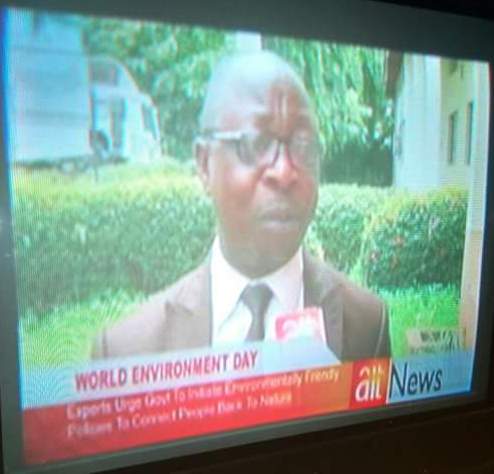APPLICATION OF BIORISK MANAGEMENT FOR TRAINING AND RESEARCH ON ANIMALS
DEPARTMENT OF ZOOLOGY AND ENVIRONMENTAL BIOLOGY STAFF SEMINAR 2017
LAGOS STATE UNIVERSITY, FACULTY OF SCIENCE
PRESENTED THURSDAY 16TH FEBRUARY 2017
This seminar was a eye opener for many, well delivered and well received. The slides can be accessed at www.slideshare.net/abiodundenloye and here are further details (summarized) of the four Biosafety Levels.
Summary of Biosafety Levels
There are four generally recognized Biosafety Levels (BSL) .
BSL – 1
a. For work with well-characterized agents not
causing disease in healthy humans.
b. The
biological agents do not pose minimal potential hazard to laboratory personnel
and the environment.
c. Precautions are limited relative to other
levels.
d. Laboratory personnel must wash their hands
when entering and exiting the lab.
e. Research with these agents may be performed on
standard open laboratory benches without the use of special containment
equipment.
f. Eating and drinking are prohibited in
laboratory areas.
g. Potentially infectious material must be
decontaminated before disposal, either by adding an appropriate disinfectant,
or by packaging for decontamination elsewhere.
h. No need for Personal protective equipment
(PPE) except for circumstances where personnel might be exposed to hazardous
material.
i.
The lab lab must have
a door which can be locked to limit access to the lab.
j.
The lab does not have
to be isolated from the general building.
k. Suitable for work with non-pathogenic Escherichia coli,
Bacillus subtilis, Saccharomyces cerevisiae and other
organisms not suspected to contribute to human disease.
l.
They are the types of
labs used for teaching in high schools
and colleges.
BSL – 2
Precautions include
all those used at BSL 1 plus others as follows:
a. Lab workers must have specific training in the
handling of biological agents.
- Access to the laboratory is limited when work is being conducted.
- Extreme precautions are taken with contaminated sharps.
- Certain procedures in which infectious aerosols or splashes may be created are conducted in biological safety cabinets or other physical containment equipment.
- Suitable for work involving agents of moderate potential hazard to personnel and the environment. This includes various microbes that cause mild disease to humans, or are difficult to contract via aerosol in a lab setting. Examples include Hepatitis A, B, and C viruses, human immunodeficiency virus (HIV), pathogenic Escherichia coli, Staphylococcus aureus, Salmonella, Plasmodium falciparum, and Toxoplasma gondii.
BSL – 3
For work involving
microbes which can cause serious and potentially lethal disease via the
inhalation route. The precautions in BSL-1 and BSL-2 labs are followed, but
includes:
a. Lab workers have medical surveillance and are immunized
against accidental or unnoticed infection.
- There must be Biological Safety Cabinet in which all work procedure must be done
- The lab worker must wear solid-front protective clothing (gowns that tie in the back).
- A lab-specific biosafety manual must be drawn and followed.
- The lab entrance must be separated from areas of the building with unrestricted traffic flow.
- The lab must be behind two sets of self-closing doors (to reduce the risk of aerosols escaping).
- The laboratory must be easy to clean.
- Carpets are not permitted, and any seams in the floors, walls, and ceilings are sealed.
- Windows must be sealed, and a ventilation system installed which forces air to flow from the "clean" areas of the lab to the other areas
- Biosafety level 3 is commonly used for research and diagnostic work involving various microorganisms that can be transmitted by aerosols and/or cause severe disease.
- Organisms handled at this level include Francisella tularensis, Mycobacterium tuberculosis, Chlamydia psittaci, Venezuelan equine encephalitis virus, Eastern equine encephalitis virus, SARS coronavirus, Coxiella burnetii, Rift Valley fever virus, Rickettsia rickettsii, Brucella, chikungunya, yellow fever virus, and West Nile virus.
BSL – 4
This is appropriate
for work with agents that could easily be aerosol-transmitted within the
laboratory and cause severe to fatal disease in humans for which there are no
available vaccines or treatments. The lab is set up to be either cabinet
laboratory or protective suit laboratory. The features include:
- It must be separated from areas that receive unrestricted traffic.
- Airflow is tightly controlled to ensure that air always flows from "clean" areas of the lab to areas where work with infectious agents is being performed.
- The entrance must have airlocks to minimize possibility of aerosols being removed from the lab.
- Lab wastes, including filtered air, water, are decontaminated before leaving the facility.
- The lab is used for diagnostic work and research on easily transmitted pathogens which can cause fatal disease.
- Organisms used in this level include viruses that are pathogens for viral hemorrhagic fever such as Marburg virus, Ebola virus, Lassa virus, Crimean-Congo hemorrhagic fever. Others include Hendra virus, Nipah virus, and some Flaviviruses. This level is also for work with Variola virus, the causative agent of smallpox.
Adapted from https://en.wikipedia.org/wiki/Biosafety_level




